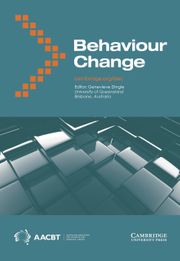Crossref Citations
This article has been cited by the following publications. This list is generated based on data provided by
Crossref.
Estrada, Ana Ulloa
and
Pinsof, William M.
1995.
THE EFFECTIVENESS OF FAMILY THERAPIES FOR SELECTED BEHAVIORAL DISORDERS OF CHILDHOOD.
Journal of Marital and Family Therapy,
Vol. 21,
Issue. 4,
p.
403.
Arco, Lucius
and
Millett, Roslyn
1996.
Maintaining Instructional Behavior After On-the-Job Training with Process-Based Performance Feedback.
Behavior Modification,
Vol. 20,
Issue. 3,
p.
300.
Hall, Laura J.
and
Smith, Kerry L.
1996.
The generalisation of social skills by preferred peers with autism.
Journal of Intellectual & Developmental Disability,
Vol. 21,
Issue. 4,
p.
313.
Smith, Tristram
and
Lovaas, O. Ivar
1997.
The UCLA Young Autism Project: A Reply to Gresham and MacMillan.
Behavioral Disorders,
Vol. 22,
Issue. 4,
p.
202.
Ryan, Jeremy P
and
Murkies, Arlene S
1997.
Autism: time for a national approach to early assessment and management.
Medical Journal of Australia,
Vol. 166,
Issue. 8,
p.
443.
Hall, Laura J.
1997.
Effective Behavioural Strategies for the Defining Characteristics of Autism.
Behaviour Change,
Vol. 14,
Issue. 3,
p.
139.
Arco, Lucius
1997.
Improving Program Outcome with Process-Based Performance Feedback.
Journal of Organizational Behavior Management,
Vol. 17,
Issue. 1,
p.
37.
Mundy, Peter
and
Crowson, Mary
1997.
Joint Attention and Early Social Communication: Implications for Research on Intervention with Autism.
Journal of Autism and Developmental Disorders,
Vol. 27,
Issue. 6,
p.
653.
Rogers, Sally J.
1998.
Neuropsychology of autism in young children and its implications for early intervention.
Mental Retardation and Developmental Disabilities Research Reviews,
Vol. 4,
Issue. 2,
p.
104.
1998.
A Review of Behavioural Early Intervention Programmes for Children with Autism Michael Connor.
Educational Psychology in Practice,
Vol. 14,
Issue. 2,
p.
109.
Ryan, Jeremy
1998.
Autism.
The Lancet,
Vol. 351,
Issue. 9106,
p.
912.
Rogers, Sally J.
1998.
Empirically supported comprehensive treatments for young children with autism.
Journal of Clinical Child Psychology,
Vol. 27,
Issue. 2,
p.
168.
Pailthorpe, Wendy K.
and
Ralph, Alan
1998.
Time-out as a Means of Shaping Whole-task Completion as a Precursor to Establishing Rule-following Behaviour with a Severely Noncompliant Preschool Child.
Behaviour Change,
Vol. 15,
Issue. 1,
p.
50.
Graff, Richard B.
Green, Gina
and
Libby, Myrna E.
1998.
Effects of two levels of treatment intensity on a young child with severe disabilities.
Behavioral Interventions,
Vol. 13,
Issue. 1,
p.
21.
Hixson, Michael D.
1998.
Ape Language Research: A Review and Behavioral Perspective.
The Analysis of Verbal Behavior,
Vol. 15,
Issue. 1,
p.
17.
Olley, J. Gregory
1999.
Curriculum for Students with Autism.
School Psychology Review,
Vol. 28,
Issue. 4,
p.
595.
Weisz, John R.
and
Jensen, Peter S.
1999.
Efficacy and Effectiveness of Child and Adolescent Psychotherapy and Pharmacotherapy.
Mental Health Services Research,
Vol. 1,
Issue. 3,
p.
125.
Smith, Tristram
1999.
Outcome of early intervention for children with autism..
Clinical Psychology: Science and Practice,
Vol. 6,
Issue. 1,
p.
33.
Gresham, Frank M.
Beebe-Frankenberger, Margaret E.
and
MacMillan, Donald L.
1999.
A Selective Review of Treatments for Children with Autism: Description and Methodological Considerations.
School Psychology Review,
Vol. 28,
Issue. 4,
p.
559.
Anderson, Stephen R.
and
Romanczyk, Raymond G.
1999.
Early Intervention for Young Children with Autism: Continuum-Based Behavioral Models.
Journal of the Association for Persons with Severe Handicaps,
Vol. 24,
Issue. 3,
p.
162.

